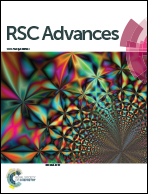The effects of nonmetal dopants on the electronic, optical, and catalytic performances of monolayer WSe2 by a first-principles study†
Abstract
Doping modifies the electronic, optical, and catalytic behavior of materials through the newly formed chemical bonds and the localized electrons. With the aid of first-principles calculations, the electronic, optical, and catalytic performances of the nonmetal (NM = H, B, C, N, O, F, Si, P, S, Cl, As, Br, Te, or I)-doped monolayer WSe2 were investigated. The results showed that the NM dopants substitute preferentially for Se under a W-rich condition and H, F, Cl, Br, and I atoms are willing to locate at the interstitial site. The electron-clouds around the dopants and nearby W or Se atoms were altered by the newly formed W–NM or Se–NM bonds, with the differences determined by the bonding strength between them. The band gap, optical absorption edge, and intensities were altered or shifted by less than 0.08 eV, 32 nm, and 9.5%, respectively. The H, F, P, Cl, As, Br, and I dopants were conductive to separating the photogenerated e−/h+ pairs, whereas the B, C, Si, and Te dopants became recombination centers for the photogenerated e−/h+ pairs. Compared with pristine monolayer WSe2, NM atoms with odd free electrons reduced the reduction potential by 0.39–0.71 eV and enhanced the oxidation potential by 0.45–0.75 eV. Thus, we can adjust the redox potentials of monolayer WSe2 by introducing different kinds of NM impurities for various catalytic reactions, and the H-, F-, P-, Cl-, As-, Br-, and I-doped specimens have excellent photocatalysis capability.


 Please wait while we load your content...
Please wait while we load your content...